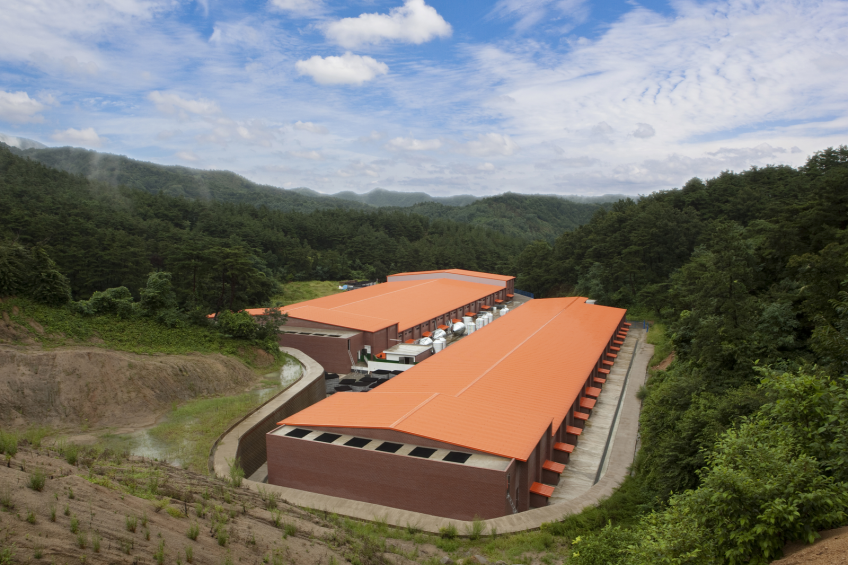Ventilating alone is not enough – know the air flow

Optimising a good climate in pig houses is a matter of accuracy. No rule of thumb exists – requirements of a ventilation system are largely dependent on the outside climate, a pig house interior, occupancy rate as well as the air inlet system used.
By Patrick van Dijk, Fancom, the Netherlands
Worldwide, demand to meat is growing. Where the meat industry is still developing, a large tendency can be observed towards getting more grip on production processes as well as quality in order to be less dependent on importing meat. More grip also allows control of issues like food safety and prices, as high production costs, disease and mortality often constitute large problems. Constructing closed environments is usually considered a first step to overcome these problems. The proportion of mechanically ventilated pig houses is therefore growing all over the world.
Western Europe has often been an inspiration for mechanically ventilated constructions as the concept has been developed there for years. In South Korea recently pig houses arose with central ventilation after European example. This choice was made not so much because of local legislation, but rather because owners aimed to control the climate inside their pig houses as well as save on costs. In addition, they aimed to reduce odours for their neighbours as much as possible.
It is a fallacy to think, however, that one climate system design can be reproduced anywhere else with similar results. Needs vary from place to place. In hot and humid South East Asia, heat stress ought to be combatted by high air speeds, while in Russia emphasis should be on heating incoming air to manage extreme temperature differences outside. In addition, conventional pig house building, financing (im)possibilities, local legislation and of course producer preferences play an important role. The climate system always should consist of a balanced combination of air inlets and outlets. The inlet should take care of a good air distribution throughout the entire pig house without causing an annoying draught for the animals.
No universal answers exist – suppliers of climate systems can generally make a meticulous calculation of used fan capacity and advise on the most efficient installation.
Permanent analysis
Once a purpose-built pig house is built and the ventilation is regulated by predetermined curves, the finishing touch is formed by permanent analysis. This last step is of paramount importance. What if animals do not perform according to expectations? What if health problems occur?
A pig house’s climate often plays an important role with these problems. When designing ventilation systems, however, usually there is not enough attention for exact minimum ventilation, despite the notion that minimum ventilation for young animals is important to create the right growth conditions. An exact and consistent minimum air flow can be achieved by using measure fans, applied underneath the ceilling. Valves will adjust whenever necessary. This way of measuring and readjusting guarantees optimal thermic comfort for animals without temperature fluctuations or a draught.
Knowing air flow is important as in this respect, too much ventilation is a common problem. It is easy enough to start generating more ventilation when animals are perceived to be hot. Apart from a higher energy bill, however, this usage of higher air speeds cools down animals too rapidly, potentially leading to respiratory problems or ear and tail biting. Avoiding the animals from getting overheated is therefore recommended. This is only possible when a temperature sensor is at the right place, registering the temperature at animal level.
A practical example may illustrate this – in one piglet house with door ventilation, problems like ear biting and ear necrosis had been occurring from the very beginning. The producer suspected the climate to be the cause and indeed, climate graphs showed extreme temperature fluctuations. The cause of all this turned out to be the temperature sensor, positioned right on top of the pen separation, right where incoming air flew in. Unstable measurements therefore did not give a correct representation of the pig house climate. The problem was solved by moving the sensor 30 cm to the side, outside the air flow, where measurements proved to be accurate and reliable. Health problems were something of the past as from that moment.
Moving one step further, one can wonder whether it really is necessary to be dependent on sensors measuring environmental factors like temperature and humidity. Animal behaviour after all may be a much better indication to determine accurately the desired climate conditions. Pigs feeling too cold will lie closely together, often close to the wall with their legs underneath them to avoid contact with the floor. Pigs that are too hot, on the other hand, lie around scattered through the pen, preferably on a moist surface. Techniques exist to register these kinds of behaviour automatically on camera, so automatic registration could occur continuously and in real time. The method can be considered more accurate than direct pork producer observations as them entering the pig house usually means a disturbance thus whatever he sees is likely to be a bad representation of the actual situation.
In addition, automated measurements in pig houses give a host of data on climate and animal behaviour. By analysing, combining and reporting these data through software, producers will be able to get a better insight into the on-farm processes, like animal development. By combining this with things like feed and water consumption and energy usage, an even wider picture emerges of efficacy and efficiency of his management. This in turn brings important information on a producer’s financial results, but it can also be placed in responding to aspects like sustainability and animal welfare.
A good design of a climate system only is not sufficient. Monitoring, controlling and analysing of the climate process is the way to make a climate system function in all climatological circumstances.











